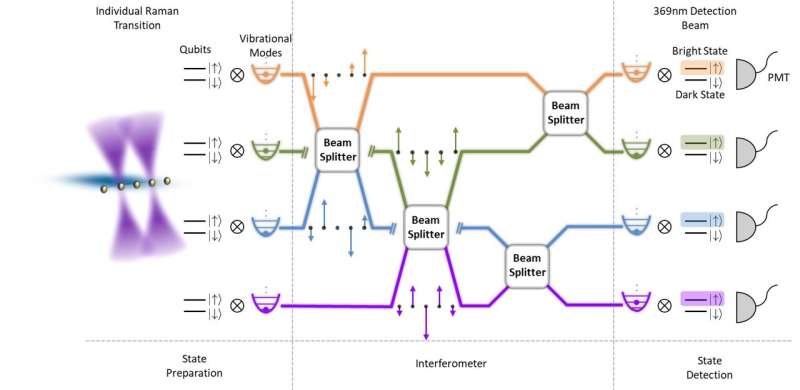(Left) Experimental setup. Five Yb+ ions are aligned in a segmented-blade trap to realize a phononic network. Two Raman lasers are used to manipulate the internal and vibrational energy levels of ions, which consists of a global beam (blue) and individually addressing beams (purple) for full control of the phononic network. (Right) A phononic network of vibrational modes. The phononic network also consists of three parts: input-state preparation, programmable beam-splitting operations, and detection. The vibrational modes are denoted by different colors, where arrows in each mode indicate the coupling strengths of the mode to different ions. All the prepared states are sent to an interferometer that consists of several Raman-driven beam splitters, and the final outputs are detected at the end of the network." Credit: Chen et al.
Quantum computing systems have the potential to outperform classical computers on some tasks, helping to solve complex real-world problems in shorter times. Research teams worldwide have thus been trying to realize this quantum advantage over traditional computers, by creating and testing different quantum systems.
Researchers at Tsinghua University recently developed a new programmable quantum phononic processor with trapped ions. This processor, introduced in a paper in Nature Physics, could be easier to scale up in size than other previously proposed photonic quantum processors, which could ultimately enable better performances on complex problems.
"Originally, we were interested in the proposal of Scott Aaronson and others about Boson sampling, which might show the quantum advantages of simple linear optics and photons," Kihwan Kim, one of the researchers who carried out the study, told Phys.org. "We were wondering if it is possible to realize it with the phonons in a trapped ion system."
The use of phonons (i.e., sound waves or elementary vibrations) to create quantum computing systems was theoretically explored for some time. In recent years, however, physicists created trapped-ion systems created the technology necessary to use phonons as a quantum information processing resource, rather than mere mediators for entangling qubits.
"It has been shown that phonons at a harmonic potential can coherently transfer to the other harmonic potential and these phonons can interfere with each other," Kihwan Kim explained. "When we learned that a modified boson sampling (Gaussian boson sampling) can also be applied to a chemical problem (i.e., vibrational sampling) we demonstrated the sampling of SO2 molecules and developed a method to create a highly entangled phononic state; yet this was limited to a single ion. In this work, we finally implemented the phononic network in a scalable way, overcoming the limits of single ions."
The system created by Kihwan Kim and his colleagues is a programmable bosonic network, a network consisting of a set of bosonic modes, connected to each other via controllable beam splitters. They realized this network using phonons, excitations of collective vibrational modes that are also bosons.
"Our system is scalable because the number of collective vibrational modes proportionally increases with the number of ions and we demonstrated how to use the additional vibrational modes and ions in a programmable way," Kihwan Kim said. "Basically, we control the vibrational mode by a properly assigned qubit. We can program the phase and ratio of each beam splitter by controlling the phase and the duration of the individually addressed laser beams."
The phononic quantum processor created by Kihwan Kim and his colleagues has several advantages over previously proposed bosonic networks. Firstly, the input and output of the phonons in the processor are deterministically prepared and detected. Furthermore, the loss of phonons over time is minimal, while in other bosonic networks based on photons losses is an issue to overcome.
"Boson sampling can be a powerful tool for certain tasks in quantum algorithms and simulations," Myungshik Kim, another researcher at Imperial College involved in the study, told Phys.org. "While boson sampling has been mostly realized by photons, there are technical difficulties in realizing scalable boson sampling because single photon generation is probabilistic and photon loss on a chip is high. In our work we use phonons of the ions in a harmonic potential instead of photons. The clear advantages of this are that we can generate quantum states of phonons deterministically and do not lose phonons during the process."
Boson sampling is a model of quantum computation that can be very advantageous for tackling some tasks using quantum algorithms or simulations. Boson sampling is typically realized using several distinct techniques.
Kihwan Kim, Myungshik Kim and their colleagues were able to implement all these techniques in a single platform, which could have notable advantages for the development of larger systems. This was achieved by reconstructing the states of phonons in their network.
In the future, the phononic network they created could be scaled up to achieve large-scale and programmable boson sampling. In addition, their work could inspire the development of other programmable quantum networks based on phonons and trapped ions.
"Now, it is important for us to scale up our system and hopefully use it to demonstrate quantum advantage over classical computing," Kim added. "At the same time, we may also try to achieve continuous-variable universal quantum computation with the qubit-controlled beam splitter."
More information: Wentao Chen et al, Scalable and programmable phononic network with trapped ions, Nature Physics (2023). DOI: 10.1038/s41567-023-01952-5
Journal information: Nature Physics
© 2023 Science X Network
























